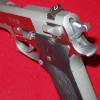Denny Hansen
Member
No.
One doesn't expect such problems in Glocks, nor do I hear of many problems of late with Smith & Wesson and Ruger revolvers. My father has a Sig P220 that's never had a jam and I have a Smith 645 that's also never had a jam. One guy has buried his Glock, thrown it down on the concrete, dumped it in the mud and then froze it. When it survived all that he threw it out of a helicopter and the thing still shot. I have several Smith and Ruger revolvers and they work flawlessly. There are a few complaints, but not as many as I've heard from Kimber owners. Recall, too, that many of these revolvers mentioned are $280-$700, not quite up to the $1,200 someone has to shell out for a Kimber, only to find out that it jams every now and then. Smith & Wesson reps demonstrated their 645s a few years back by putting an empty cartridge in a clip and then having it feed into the gun. It was amazing.While some will experience problems with Kimbers, this is to be expected by any product from any company that produces the lion's share of models in a given category.
Ruger hasn't resorted to it and probably never will. Plus, when one spends more than a grand for a Kimber, one might expect parts that are solid all the way through and not just hardened on the surface? MIM parts are a cost cutting measure, not a revolutionary improvement to make them better.There is a lot of talk about "MIM" in Kimber pistols, but the truth is that they have the exact same MIM parts that Colt, Springfield, Para, S&W and every non-custom 1911 comes with these days.
True, but one reason South Africans bought a lot of Rugers back in the days they had economic sanctions against them was because they knew that Rugers could last a lifetime and, if something did wear out, many tinkerers could just make a new part that was easy to install. Also, Glocks and many other newly designed autos are known for not needing a lot of parts replacements. The 1911, however, is an older design that was quite good in its day, but even now (regardless of who makes them) they're known to need parts replacement every now and then. Kimber is a good company, but I don't know of any company that can produce an out-of-the-box 1911 that can compete against a new tech out-of-the-box pistol. In the military trials, I think the control Colt 1911 came in about last. The Beretta 92 malfunctioned on an average of about once every 2,000 rounds. The Smith & Wesson 459 came in second place with one malfunction in every 950 rounds.Shoot it and know that parts will wear out and when they do they will need to be replaced. This isn't something new nor is it something that is only associated with Kimbers or 1911s.


